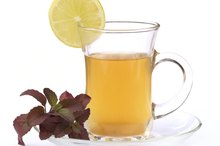What does fact checked mean?
At Healthfully, we strive to deliver objective content that is accurate and up-to-date. Our team periodically reviews articles in order to ensure content quality. The sources cited below consist of evidence from peer-reviewed journals, prominent medical organizations, academic associations, and government data.
The information contained on this site is for informational purposes only, and should not be used as a substitute for the advice of a professional health care provider. Please check with the appropriate physician regarding health questions and concerns. Although we strive to deliver accurate and up-to-date information, no guarantee to that effect is made.
One of the most commonly consumed drinks in the world, tea provides a delicious and healthy source of hydration. Tea is made my steeping the leaves of the tea plant in water or milk, and allowing the nutrients and chemicals from the tea leaves to seep into the drink. Among these chemicals are vitamins and minerals, nutrients which prove essential to the health of your body.
Vitamin C
One vitamin found in tea is vitamin C, or ascorbic acid 1. Vitamin C serves a number of roles within your body: it helps in the production of collagen, a substance that provides strength to a number of tissues including your bones, blood vessels and tendons. It also aids in tissue repair and wound healing, helping your body recover from injury, according to the University of Maryland Medical Center 12. Consuming sources of vitamin C -- such as tea -- may therefore help fight vitamin C deficiencies and help maintain the strength and health of your cells and tissues.
Vitamin K
The Side Effects of Feiyan Tea
Learn More
Another vitamin found in tea, specifically green tea, is vitamin K. Though not an essential nutrient -- since bacteria in your digestive tract can synthesize the vitamin -- vitamin K consumption through drinking tea can prove beneficial to your heath. Vitamin K aids in the formation of blood clots following injury or tissue damage, an initial step in wound healing. However, the vitamin K content of green tea may also present some risks -- the University of Maryland Medical Center indicates that vitamin K in tea may interfere with other medications, such as warfarin and aspirin 12. If you currently take blood-thinning medication, consult with your doctor about the safety of drinking green tea.
- Another vitamin found in tea, specifically green tea, is vitamin K. Though not an essential nutrient -- since bacteria in your digestive tract can synthesize the vitamin -- vitamin K consumption through drinking tea can prove beneficial to your heath.
- However, the vitamin K content of green tea may also present some risks -- the University of Maryland Medical Center indicates that vitamin K in tea may interfere with other medications, such as warfarin and aspirin 1.
Vitamin E
Tea also contains the essential nutrient vitamin E. This vitamin acts as an antioxidant -- its role in your body is to protect against damage by free radicals, the harmful chemical byproducts of your body's metabolism. Free radicals damage your cells, causing genetic mutations. According to the University of Maryland Medical Center, the vitamin E content of tea also proves beneficial in helping your body utilize and absorb other nutrients within the beverage, such as vitamin K 12.
Fluoride
Tulsi Tea and Pregnancy
Learn More
One mineral found in tea is fluoride. Though fluoride represents a non-essential mineral in your body, fluoride in your diet proves beneficial in maintaining healthy teeth. Specifically, fluorine can increase the hardness and strength of the mineralized, bony tissue within your teeth, helping to prevent tooth decay and cavities. The Linus Pauling Institute at Oregon State University notes that higher quality green and black teas both provide a good source of fluoride, while lower quality tea, known as brick tea, contains high levels of the mineral 23. To increase the fluoride content of your tea, prepare the beverage using fluoridated water, such as tap water.
- One mineral found in tea is fluoride.
- Though fluoride represents a non-essential mineral in your body, fluoride in your diet proves beneficial in maintaining healthy teeth.
Related Articles
References
- University of Maryland Medical Center: Vitamin C (Ascorbic Acid)
- University of Maryland Medical Center: Green Tea
- Linus Pauling Institute: Tea
- Holick MF, Gordon CM. Patient Guide to Vitamin D Deficiency. The Journal of Clinical Endocrinology & Metabolism. 2011;96(7):1-2. doi:10.1210/jcem.96.7.zeg33a
- Sunyecz JA. The use of calcium and vitamin D in the management of osteoporosis. Ther Clin Risk Manag. 2008;4(4):827-836. doi:10.2147/tcrm.s3552
- Giovannucci E, Liu Y, Hollis BW, Rimm EB. 25-hydroxyvitamin D and risk of myocardial infarction in men: a prospective study. Arch Intern Med. 2008;168(11):1174-1180. doi:10.1001/archinte.168.11.1174
- Gorham ED, Garland CF, Garland FC, et al. Optimal vitamin D status for colorectal cancer prevention: a quantitative meta analysis. Am J Prev Med. 2007;32(3):210-216. doi:10.1016/j.amepre.2006.11.004
- Lappe JM, Travers-Gustafson D, Davies KM, Recker RR, Heaney RP. Vitamin D and calcium supplementation reduces cancer risk: results of a randomized trial. The American Journal of Clinical Nutrition. 2007;85(6):1586-1591. doi:10.1093/ajcn/85.6.1586
- Prentice RL, Pettinger MB, Jackson RD, et al. Health risks and benefits from calcium and vitamin D supplementation: Women’s Health Initiative clinical trial and cohort study. Osteoporos Int. 2013;24(2):567-580. doi:10.1007/s00198-012-2224-2
- Urashima M, Segawa T, Okazaki M, Kurihara M, Wada Y, Ida H. Randomized trial of vitamin D supplementation to prevent seasonal influenza A in schoolchildren. Am J Clin Nutr. 2010;91(5):1255-1260. doi:10.3945/ajcn.2009.29094
- Salehpour A, Hosseinpanah F, Shidfar F, et al. A 12-week double-blind randomized clinical trial of vitamin D₃ supplementation on body fat mass in healthy overweight and obese women. Nutr J. 2012;11:78. doi:10.1186/1475-2891-11-78
- Carrillo AE, Flynn MG, Pinkston C, et al. Impact of vitamin D supplementation during a resistance training intervention on body composition, muscle function, and glucose tolerance in overweight and obese adults. Clin Nutr. 2013;32(3):375-381. doi:10.1016/j.clnu.2012.08.014
- Marcinowska-Suchowierska E, Kupisz-Urbańska M, Łukaszkiewicz J, Płudowski P, Jones G. Vitamin D Toxicity-A Clinical Perspective. Front Endocrinol. 2018;9:550. doi:10.3389/fendo.2018.00550
- Ross AC, Manson JE, Abrams SA, et al. The 2011 report on dietary reference intakes for calcium and vitamin D from the Institute of Medicine: what clinicians need to know. J Clin Endocrinol Metab. 2011;96(1):53-58. doi:10.1210/jc.2010-2704
- Bouillon R, Van Schoor NM, Gielen E, et al. Optimal vitamin D status: a critical analysis on the basis of evidence-based medicine. J Clin Endocrinol Metab. 2013;98(8):E1283-E1304. doi:10.1210/jc.2013-1195
- American Academy of Dermatology. Position Statement of Vitamin D. 2010.
- Taksler GB, Cutler DM, Giovannucci E, Keating NL. Vitamin D deficiency in minority populations. Public Health Nutr. 2015;18(3):379-391. doi:10.1017/S1368980014000457
- Holick MF, Binkley NC, Bischoff-Ferrari HA, et al. Evaluation, treatment, and prevention of vitamin D deficiency: an Endocrine Society clinical practice guideline. J Clin Endocrinol Metab. 2011;96(7):1911-1930. doi:10.1210/jc.2011-0385
- Cannell JJ, Vieth R, Umhau JC, et al. Epidemic Influenza and Vitamin D. Epidemiol Infect. 2006; 134:1129-40.
- Carrillo AE1, Flynn MG, Pinkston C, Markofski MM, Jiang Y, Donkin SS, Teegarden D. Impact of Vitamin D Supplementation During a Resistance Training Intervention on Body Composition, Muscle Function, and Glucose Tolerance in Overweight and Obese Adults. Clin Nutr. 2013 Jun;32(3):375-81. doi: 10.1016/j.clnu.2012.08.014. Epub 2012 Aug 31.
- Ginde AA, Mansbach JM, Camargo CA, Jr. Association Between Serum 25-Hydroxyvitamin D Level and Upper Respiratory Tract Infection in the Third National Health and Nutrition Examination Survey. Arch Intern Med. 2009; 169:384-90.
- Giovannucci E, Liu Y, Hollis BW, Rimm EB. 25-hydroxyvitamin D and Risk of Myocardial Infarction in Men: a Prospective Study. Arch Intern Med. 2008; 168:1174-80.
- Gorham ED, Garland CF, Garland FC, Grant WB, Mohr SB, Lipkin M, Newmark HL, Giovannucci E, Wei M, Holick MF. Optimal Vitamin D Status for Colorectal Cancer Prevention: a Quantitative Meta-analysis. Am J Prev Med. 2007 Mar;32(3):210-6.
- Heaney, Robert P. “The Vitamin D Requirement in Health and Disease.” The Journal of Steroid Biochemistry & Molecular Biology 97 (2005):13-9.
- Holick MF. Vitamin D. In: Shils M, Olson J, Shike M, Ross AC, ed. Modern Nutrition in Health and Disease, 9th ed. Baltimore: Williams and Wilkins, 1999.
- National Institutes of Health Office of Dietary Supplements. Vitamin D: Dietary Supplement Fact Sheet. University of Ottawa Evidence-based Practice Center. Effectiveness and Safety of Vitamin D in Relation to Bone Health. Agency for Healthcare Research and Quality. Aug 2007: 07-E013.
- Salehpour A1, Hosseinpanah F, Shidfar F, Vafa M, Razaghi M, Dehghani S, Hoshiarrad A, Gohari M. A 12-week Double-blind Randomized Clinical Trial of Vitamin D₃ Supplementation on Body Fat Mass in Healthy Overweight and Obese Women. Nutr J. 2012 Sep 22;11:78. doi: 10.1186/1475-2891-11-78.
- Urashima M, Segawa T, Okazaki M, Kurihara M, Wada Y, Ida H. Randomized Trial of Vitamin D Supplementation to Prevent Seasonal Influenza A in Schoolchildren. Am J Clin Nutr. 2010 91:1255-60. Epub 2010 Mar 10.
- Wilkins, Consuelo H. and Yvette I. Sheline, et al. “Vitamin D Deficiency Is Associated with Low Mood and Worse Cognitive Performance in Older Adults.” American Journal of Geriatric Psychiatry 14 (2006): 1032-40.
Writer Bio
Sylvie Tremblay holds a Master of Science in molecular and cellular biology and has years of experience as a cancer researcher and neuroscientist.









